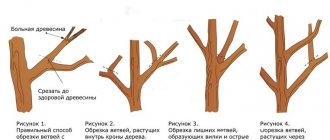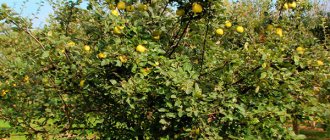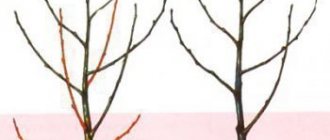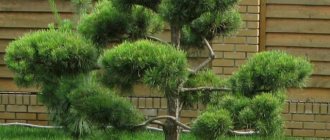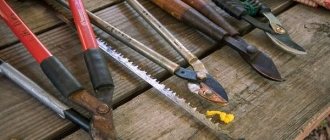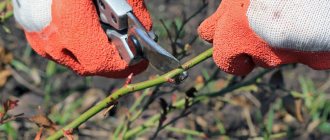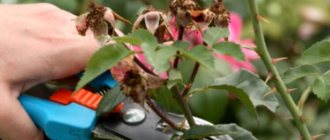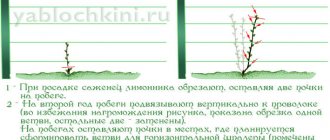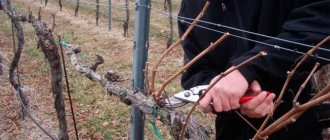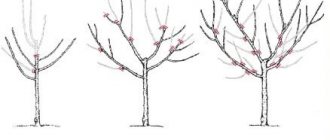Apricot trees produce delicious fruits with a sweet-tart flavor. Fruits are endowed with a wealth of vitamins and carbohydrates, useful micro- and macroelements. But apricot is characterized by increased growth intensity. This feature has a detrimental effect on the development of the top and the entire plant. It is precisely because of its rapid growth that apricot is susceptible to many diseases. Intensive reproduction of shoots contributes to the drying out and death of the tree. But such problems can be easily solved by providing optimal care for the plant. Next, we’ll look at how to competently carry out the process of pruning apricots in the fall for beginning gardeners.
Why do you prune apricots?
Apricot pruning is carried out according to a certain pattern. It is important to properly cut off the branches so as not to harm the tree. Pruning purposes:
- Rejuvenation. In spring and autumn, branches are pruned to rejuvenate the tree and form a crown.
- Receiving the harvest. By preventing the growth of the crown, they achieve faster and more massive fruiting.
- Prevention of thickening of branches. To make it easier to harvest
If you abandon a tree without pruning it, it will produce a lot of fruit at first. But after a few years, the abundance of apricot ends - the crown grows and thickens, and the internal branches quickly age, become “bald”, and the number of buds laid on them is sharply reduced.
Consequences of crown thickening:
- the fruits become small;
- quality indicators of fruits fall;
- Fruiting is periodic.
The thick, branched branches of the apricot tree are both flexible and fragile. Without pruning, they become overloaded with fruit. Under the weight of the harvest, the branches break off, which means new shoots do not grow - the yield decreases. Thanks to proper pruning, the apricot:
- bears fruit regularly;
- the fruits grow large and juicy;
- the lifespan of the tree increases.
When to prune an apricot, in spring or autumn and timing
Cutting apricot shoots is an event that is carried out in a complex. It is carried out in almost all seasons. It all depends on the purpose of the procedure. The most suitable time is spring and autumn, before and after the start of sap flow. At this time, the plant does not spend much energy on restoration and healing of wounds.
In the spring, shoots are cut off when the snow begins to melt. But the first leaves should not begin to appear yet. In most regions this is the beginning or middle of April.
And in the fall, after the leaves fall, when the movement of sap stops, but before frost, 2-3 weeks. This is necessary for the plant to adapt to winter. The ideal time for autumn pruning of apricot is mid-October.
What tools are needed?
Every amateur gardener should stock up on a whole arsenal of various fruit tree care products:
- pruning shears - manual or air;
- grafting, gardening, copulating and budding knife;
- garden saw;
- triangular file;
- belt for pointing and straightening cutting tools;
- whetstone and whetstone;
- twine - it will be needed to secure the branches;
- chisel - for cleaning wounds;
- garden varnish, paint - to cover damage.
Experienced gardeners are sure that instead of garden pitch and other petroleum products, it is necessary to use materials that are harmless to wood - lanolin or beeswax.
You will also need copper sulfate. Its 1% solution is used to disinfect the instrument and treat the sections.
Preparing tools
High-quality pruning of apricot trees is impossible without the appropriate equipment. All tools must be well sharpened. To keep your garden knife sharp, you need to use a wet whetstone, which is excellent at removing sawdust. A dull pruner should be disassembled before use to sharpen the cutting blade. After collection, the tool must be checked for functionality. You can adjust the pruning shears through the tension nut: if the grip is too tight, then loosen it, if it is loose, tighten it.
To care for an apricot tree you need to have the following tools:
- Special grafting knife.
- Secateurs.
- Sharpening stone.
- A product for sealing cuts (for example, garden pitch).
- Strong twine for supporting branches and shoots.
Important!
Before using a garden saw, its teeth must be set in opposite directions (alternating their tilt to the left and to the right). In this case, all sharp parts should be directed inward. Tools must be thoroughly disinfected to protect the tree from pests and diseases.
How to prepare the tool for use?
Before work, cutting tools are carefully sharpened:
- Chamfering. When sharpening knives - gardening, budding and copulating knives, grind the chamfer until a wedge appears, smooth, without blockages or bends, from the tip to the butt.
- Sharpen knives on a fine-grained whetstone.
- They straighten the knife using a whetstone.
During sharpening, the whetstone and the whetstone are moistened with water to remove iron filings, graphite and carborundum.
- The grafting knife should be adjusted on a belt lubricated with a special paste.
The tool, ready for use, is comparable in sharpness to a sharp razor blade. It is enough to correct a slightly dull garden knife on a whetstone - right while working. Grafting knives must be adjusted additionally - on a belt.
It is important that during operation the tool does not become duller than required. After work, all used accessories are cleaned of dirt and wiped with a dry cloth. If the instrument is stored, its metal parts are lubricated.
We cut it correctly
To achieve maximum effect from autumn pruning, it is important to consider the following recommendations:
- Last year's shoots should be cut near the buds, with the plane of the cuts in the upper part should pass above the buds, and in the lower part - at the level of the base of the buds. Stumps should not be left, as microorganisms that cause diseases can develop on them.
- You need to make a cut under the ring according to the flow that is on the branches. It is impossible to cut a branch parallel or perpendicular to the trunk - a serious wound will form.
- You need to choose a pruning tool based on the size of the branch. Thin branches are cut using pruning shears, and thick branches are cut with a saw. At the same time, it is very important that the tools are sharp, otherwise they will tear the tree bark or infect it with diseases. To achieve the most even surface, the cut areas are cleaned with a garden knife.
- If the apricot crown is very thick, it is necessary to cut off all the branches from the inside that grow downwards.
- On mature trees, first of all, old and weak branches are thinned out, and then incorrectly growing shoots.
- Do not forget to compare the potential (varietal) and actual bud awakening on the plant. This will help prevent thickening of the crown instead of its thinning and, conversely, thinning of the already sparse crown.
Apricot branches should be pruned at the bud level or strictly along the bulge that exists inside the branch.
Video: autumn pruning of fruit crops
Trimming technology
Pruning work is carried out using several standard techniques. The choice of technology depends on the type of branches to be pruned and the tasks assigned to the gardener.
Cutting branches into a ring
Used if you need to remove the entire shoot without stimulating the growth of others. This technique is used for shoots damaged by disease or frost, as well as for eliminating “tops”.
To make a competent cut, it is important to position it correctly. The task is simplified on branches with a clearly defined annular influx, which is located on the border between neighboring shoots. The cut is made exactly along the upper edge of the ring.
The ring is an influx containing cells that have the ability to reproduce rapidly. It is this property that allows the wound to heal faster.
Cutting technique:
- To reduce pain when cutting thick branches, a cut is made from below - by 1/3. You need to step back from the trunk at a distance of 10-20 cm.
- Sawing is done from above - the branch is removed.
- The stump must be cut along the ring.
- To make the cut smooth, it is cleaned with a knife - for better healing.
- The saw cut must be disinfected with a 1% solution of copper sulfate.
- Cover the cut with garden varnish, paint, wax or lanolin - gardeners themselves decide which composition is best.
If you leave the stump or cut off the ring, the process of decay begins. Hollows may form in the wound. There is a danger of pests and infections.
If there is no ring, you can make a bevel cut. How to do it? Draw one imaginary line at the base of the branch - along the trunk. The other one - from the point of intersection of the branch with the trunk - at an angle of 90 degrees. Dividing the resulting angle in half, cut off the branch.
Pruning "to the bud"
The technique refers to formative pruning, in which the section of the branch above the bud is removed. The cut is oblique. The upper part of the cut is located half a centimeter above the bud - always on the bud side. This technique allows you to regulate the direction of shoot growth.
Pinching (pinching) shoots
A pruning technique in which the length of the shoots is reduced by 1/3 of the length. This technique allows you to accelerate the ripening of shoots and also stimulates lateral branching.
Kidney blindness
This technique prevents uncontrolled shoot regrowth. This is the least painful technique, which is used at the initial stage of shoot emergence. Having noticed an extra branch, it is pinched off.
After care
Apricots after pruning need more careful care than before. This is a traumatic and stressful procedure. Immediately after the cut, the wound should be disinfected so that bacteria do not penetrate deeper. How you can do this:
- solutions of copper or iron sulfate;
- potassium permanganate;
- Bordeaux mixture;
- store-bought special balms;
- fungicides.
The next day, it is advisable to seal the cut to speed up regeneration. Recommended products:
- garden varnish (can be bought in a store or prepared at home from paraffin, rosin, drying oil, interior fat and other ingredients);
- a mixture of clay and cow dung;
- water-based or oil-based paint on natural drying oil (however, many gardeners do not recommend using paint for processing cuts, as it can be toxic);
- cement (can only be used if the tree has been cut into a ring);
- artificial bark (a popular acrylic-based varnish-balm).
The cuts should be sealed with the thinnest layer, otherwise moisture will accumulate under the applications, which provokes the formation of rot. After these procedures, the apricot will need care for 2-3 weeks:
- watering every 3 days at the roots (more often in hot weather);
- loosening the tree trunk circle to a depth of 8-10 cm (2-3 times with an interval of one week between them);
- fertilizing with fertilizers (in spring - nitrogen, in autumn - ordinary mineral);
- mulching;
- monitoring the cut sites: how quickly they regenerate and whether they rot.
Types of pruning
In one season, apricots are subjected to five types of pruning:
- Formative. This pruning is necessary for normal branching and the formation of branches on the first tier. Allows you to design the shape of the crown and create a strong skeleton. Seedlings aged 4-5 years are exposed.
- Regulatory . Maintains crown shape. The essence of the process is thinning, adjusting and directing the shoots. Seedlings are pruned from 6-7 years old and annually - as long as the tree lives and bears fruit.
- Sanitary. It involves removing branches affected by pests and diseases. This pruning is carried out throughout the life of the plant.
- Restorative. For trees with neglected or damaged crowns. Only plants at 5-9 years of age can be corrected. After this age, you can only remove damaged branches.
- Rejuvenating. Allows you to restore fruiting in old trees. There comes a time when the growth of shoots slows down - they grow by less than 30 cm per season, and fruiting shifts to the periphery of the crown.
Without formative pruning it is impossible to form the correct branching; other options are needed to maintain the tree “in shape”. The plant should:
- well illuminated by sunlight;
- have a regular, not overgrown crown;
- give high yields.
Trees that have withstood winter frosts without consequences do not need to undergo restorative pruning.
Anti-aging pruning
Due to the high rate of shoot growth characteristic of apricots, rejuvenating pruning of old trees gives good results. It is carried out when the growth of annual shoots is less than 30 cm, which leads to exposure of skeletal branches and movement of fruiting to the periphery, its frequency, and a decrease in yield.
To rejuvenate an apricot, its old skeletal branches are cut out, leaving no more than a third of their length growing inward, extra tops, and drooping branches. The next year, new skeletal branches are selected from the young shoots, after which the crown is formed in accordance with the rules for young trees. Rejuvenation is carried out in stages - over 3 seasons:
- in the first year, only 1/3 of the old branches are removed, and the young ones that replace them are redirected to the outside with the help of stretch marks;
- the procedure is repeated the next year, with the second third of the old branches and overgrown tops removed;
- The final renewal of the crown occurs in the 3rd year, when the last third of the old branches are removed.
Formation of different types of crown
By subjecting a young apricot to formative pruning, you can create a crown of the desired shape. The formation process, starting from the moment the tree is planted, lasts 4-5 years. Complete crown formation should be completed by the sixth year of life. Before starting to trim branches, the gardener must choose the type of crown. Let's look at the existing options.
Sparsely tiered form
This is the most common crown shape. It is often used for tall trees, since the sparsely layered form allows the growth of the plant to be inhibited. Forming technique:
- A year after planting, the apricot has 2-3 branches left on the first tier. The distance between adjacent branches is about 20 cm - they need to be shortened by about a third. The remaining branches are cut into rings. The central conductor is trimmed so that it is 30-40 cm higher than the upper branch.
- After a year or two, they begin to form the second tier of the skeleton. The skeletal branches already have second-level shoots at this point. They should be left no more than 2-3 on a branch, shortened by 30%.
- After another couple of years, they begin to form the third tier. Then the central conductor is cut at the base of the upper branch.
When forming the crown, you need to adhere to the principle of subordination - the branches on the third tier are shorter than the branches on the second tier, and so on.
The specialist explains how to prune a young apricot, how to shape its crown, and why the side branches should not be higher than the central conductor:
Cupped crown
This crown shape guarantees good illumination and ventilation of the crown, and also allows it to restrain its growth. Technique for forming a cup-shaped crown:
- The first step is pruning when planting a seedling.
- On the trunk you need to select 3-4 buds (or branches - if it is a two-year-old seedling), between which the distance is about 20 cm. The selected buds are multi-directional. The remaining buds should be blinded.
- It happens that after planting the crown was not formed for 3-4 years. It's not too late to fix everything. 3 powerful branches are selected, and the rest are cut into a ring. The central conductor is also cut out at the base of the upper branch.
- In subsequent years, shoots are pruned so that they are of the same length. If some shoot begins to grow vigorously, it will become dominant and turn into a central conductor - this is not acceptable.
- Next, they are engaged in the formation of branches of the second level - two pieces each. The interval between branches is about 50 cm.
Over time, only regulatory pruning will be needed - it will be necessary to remove shoots growing inside the crown.
Transferring a branch to a side shoot
This technique can be used for any type of crown formation. Its task is to limit the growth of certain branches in the upward direction. To do this, on a branch whose growth they want to limit, they find a bud (shoot), the growth of which goes in the required direction. At this point a cut is made. A shoot that is left to grow will take on a more horizontal position. To enhance the effect, you can bend it down and fix it for a certain time. Then the new shoot is transferred to a side branch. There are two types of translation:
- Pruning is done to the outer bud or shoot. The technique is used if the crown is in a neglected state.
- Pruning to an internal bud or shoot is used when the crown is in a sparse state - when it is necessary to ensure its filling.
Trimming (shortening) for translation
Features of the procedure
There are different opinions on when to prune apricots - in spring or autumn. Experts recommend carrying out the procedure even more often - three times a year. To form the correct crown for the tree and ensure stable fruiting, unnecessary branches should be removed in early spring, mid-summer and late autumn. It is important to understand why pruning is needed:
- Rejuvenation. If the crown is too thick and bears fruit abundantly, this leads to depletion and aging of the tree.
- Formation of a beautiful crown. The gardener should remove overly long and protruding branches annually to keep the tree attractive and healthy.
- Minimizing the risk of breaking off new shoots. It is important to regulate the amount of ovary on the branches so that they do not break under the weight of the fruit.
- For sanitary purposes. Dry and affected shoots should be removed regularly.
- Increased yield. If you do not carry out scheduled pruning, the fruits will become smaller each time. After a few years, the yield level may be reduced by half.
Tree pruning depending on the season
A gardener is always full of work - the garden needs care in any season. Apricot pruning can be done at any time of the year. Seasonal events have distinctive features, let's look at them.
Spring
Pruning begins when March is almost over. Conditions for starting the procedure:
- comfortable ambient temperature;
- lack of active sap flow.
Correctly performed spring pruning is the key to high yields while maintaining the high taste characteristics of the fruit.
Spring activities include the following work:
- formation of the correct crown;
- planning sanitary and supportive procedures;
- removal of frozen and broken branches - so that the tree’s strength is not spent on restoring damaged shoots.
Summer
Until June 15, gardeners carry out chasing - rejuvenating pruning. From mid-May they begin to make shelling. All shoots that appeared in the new year are pinched - 20-25 cm.
Summer pruning is not carried out annually - only once every 3-4 years. The procedure sometimes has to be postponed due to insufficient moisture in the crop.
Summer pruning of apricot is carried out for the purpose of rejuvenation. All young shoots are trimmed, leaving no more than 20-30 cm in length. The shoots that appear after two weeks should be left with no more than 3-4 shoots, all others should be cut off.
Autumn
Autumn activities boil down to clearing the tree of diseased shoots. All branches are shortened by 30%, only the skeletal ones are left untouched. Pruning is best done in mid-October. In rainy weather or during frosts, events are not held. Thanks to autumn care, it is possible to maintain a balance of fruiting and non-fruiting branches.
Winter
Winter is the ideal time to prune branches and shape the crown. At this time, the plant has not yet “woke up”, which means that removing the branches will be less painful for the plant.
In winter, branches must be pruned at a temperature not lower than minus 8°C. In severe frosts, wood becomes brittle and the healing time of wounds increases.
Winter pruning tasks:
- formation of new shoots;
- maintaining the health of the culture.
Benefits of winter activities:
- there is no foliage - the condition of the crown is clearly visible;
- the plant experiences less stress;
- frozen wood is easier to saw - no marks are formed, which usually appear when working with a hacksaw or pruning shears;
- it is easier to install the ladder - there is no danger of damaging neighboring trees.
Deadlines
Some fruit crops undergo sanitary cutting only in the spring. Others are satisfied with the formation of the crown exclusively in the fall. Timing is important for each plant. Therefore, you need to know when to prune apricot trees. And here they stand out from the general series due to their features described above. Due to the strong growth of new, young shoots, the procedure is carried out throughout the warm season - in spring, summer, and autumn.
in spring
In what month is spring pruning carried out?
- in the southern regions of Russia - in early March;
- in the middle zone - at the end of March or the very beginning of April;
- in the Urals and Siberia - in the second ten days of April.
Under what conditions can you prune apricots in spring:
- the daytime temperature does not fall below +5°C during the week, the night temperature does not fall below 0°C;
- active sap flow in the tree has not yet begun, i.e. the buds may swell slightly, but are not ready to bloom.
What type of pruning is performed:
- sanitary - mandatory for this time of year, it allows you to remove frozen and damaged branches during the winter so that the tree does not waste strength on restoring them;
- formative - young trees are given the desired configuration (the development of skeletal branches is monitored, unnecessary ones are removed, the principle of subordination is observed);
- regulating - branches of older apricots are pruned, which will contribute to the thickening of the crown, and excess ovaries are removed in order to keep the yield under control.
In the spring, it is necessary to bring the plant out of hibernation and prepare it for flowering and fruiting.
In summer
For almost all fruit trees, such as apple or peach trees, summer pruning is optional and forced. Apricot does not fit into this rule. In any case, it needs to be trimmed and pinched, as many new shoots will appear that will quickly thicken the crown. However, one nuance should be taken into account: unlike spring and autumn, here the procedure for removing excess branches will be one-time. If we saw a fattening appendage, we removed it and disinfected it. That is, the problem must be solved as it arises.
In addition to regulatory pruning, sanitary pruning is also carried out in the summer, but not so much preventative as therapeutic. Moniliosis, fruit gray rot, curl and brown spotting of leaves, stone fruit scab, fusarium or cytospora drying - apricot does not have a very strong immune system and therefore often gets sick. All branches (including fruiting ones) that are attacked by fungus, infection or pests are immediately removed. Otherwise, the infection will spread to the rest of the plant.
in autumn
Gardeners are accustomed to the fact that all fruit trees must undergo serious crown thinning before hibernation. However, autumn pruning of apricots does not fit into the general rule here either. Firstly, it requires extreme accuracy. Secondly, shaping cutting is completely prohibited in some regions, since due to its traumatic nature there is a risk that the tree will not have time to prepare for frost.
So, the procedure is prohibited:
- in the Urals and Siberia;
- in central Russia, if a severe and early winter is expected; in other cases, you can, but do not remove more than ⅓ of the crown.
Allowed if:
- the daytime temperature during the week remains at +8°C;
- sap flow in the tree has slowed down;
- The foliage has already completely fallen off.
Deadlines:
- in central Russia - in October, preferably before the 20th, otherwise the apricot will not have time to prepare for winter;
- in the southern regions - it is possible in November, if the temperature still allows (but better in the first half).
An approximate scheme for sanitary pruning of apricot in the fall involves removing branches in the following sequence:
- dried (under the ring);
- broken;
- sick, infected, damaged by diseases or pests;
- fat shoots;
- crowns growing upward and inward;
- intertwined or rubbing against each other;
- trunk growth.
After this, you need to evaluate how much biomass has been removed and only then decide whether to carry out formative or regulatory pruning.
To summarize, we can say that there are no clearly defined dates. In gardening, the timing of pruning an apricot tree extends from the end of March until November (it is better to do this when all conditions are met). Throughout the season it needs to be trimmed, pinched, treated, shaped and controlled.
Apricot pruning instructions
To create a beautiful crown, you need to prune the tree according to a new pattern every year. Crown formation begins from the first year of planting. This is the only way to grow a strong tree that produces abundant harvests. Experienced gardeners prefer to form a sparsely tiered crown, which involves extending 5-7 main branches at a distance of 40 cm. Formation lasts from the first year until 6-7 years of age.
Seedling pruning
The formation of the crown is preceded by shortening the seedling - this operation is performed when planting the plant. The first few years, the branches grow especially actively - they need to be pruned so that the branching process begins. In apricot, the branches are not firmly attached to the central trunk, so the laying of single branches is carried out so that they extend at a large angle.
If the apricot is to grow in areas with an unfavorable climate for it, it can be grafted onto a frost-resistant rootstock to a height of up to one and a half meters. Then the seedling is cut off above the grafting point - at least 4-5 branches or buds must be left above it.
First year
In the first year of life - after planting, the seedling is shortened - the trunk is cut off at a height of 90 cm from ground level. If there are side shoots, choose two - located oppositely. The rest are cut into a ring - without stumps. Selected shoots are shortened by 50%, the main trunk is at a height of 20 cm from them.
Second year
Several more branches are allocated for the skeleton. They should be at least 35 cm from last year's shoots. The arrangement of branches on the trunk should be uniform. The branches in the lower tier are pruned, taking into account the characteristics of the variety:
- for vigorous growers – by 50%;
- in low-growing ones - by 1/3 of the length.
The second level is shortened so that the branches are 10 cm shorter than the shoots from the lower tier. The main trunk is cut at a level of 40 cm from the upper side branches.
Third year
In the third year of apricot life, the third tier of skeletal branches is laid - the principle of laying the second year is preserved. It is important to follow the principle of priority - at the bottom the branches are the strongest and longest, then 10-15 cm shorter than the previous ones. The main conductor is cut directly above the third level.
Fourth year
In the fourth year of life, fruiting begins, which means you cannot radically reduce the shoots - this may affect the fruits. Pruning in the 4th year involves cleaning the crown - removing damaged, broken and thickening branches.
After five years
The next pruning is carried out at 6-7 years of the tree’s life. Its task is to increase productivity. For this purpose, 2-3 shoots are left at the ends of all main branches. The shoots are shortened by a third. A knot is created between the shoots by cutting off a strong shoot at a distance of 10-15 cm from the base. This year they also carry out sanitary cleaning of the crown - they remove branches that thicken the crown and block the flow of light to the lower tiers.
Old apricot
Old trees need rejuvenation procedures that prolong their life and increase productivity. There are three methods of rejuvenation:
- The branches of the second tier, grown from the skeletal ones, are cut out “into a ring.” This causes active growth of young shoots. The gardener chooses those that grow horizontally or at an angle of 45 degrees - they will bear fruit. The remaining shoots are cut out. Until the branches that were left for fruiting grow, excess growth will appear - it needs to be thinned out regularly.
- Skeletal branches are replaced completely. Select 1-2 branches that will be replaced, shorten them by 20-30 cm from the trunk. When the buds wake up and new shoots begin to grow, the gardener chooses one - it will become a skeletal branch. All other shoots are methodically cut out. You need to leave a shoot growing from the bottom or side of the skeletal branch. If the outcome is successful, after 3 years you can replace other branches - one or two. You cannot cut out many thick branches in one year - this can lead to tree disease.
- The last pruning method is intermediate between the first two. The skeletal branches are not only exposed, but also shortened by half. By exposing and shortening skeletal branches, gardeners rejuvenate apricots.
Rejuvenating an old apricot
If the gardener has not properly cared for the tree, then within five years the growth of new shoots will stop. But apricot has a good regenerative function - one rejuvenating pruning is enough for it to resume branch growth. With the arrival of autumn, the gardener must adhere to two basic rules:
- Identify the oldest branches or those that have already stopped bearing fruit. It is forbidden to remove all unnecessary shoots at once. For work you need to use a sharp saw.
- Among all the variety of branches you need to find the youngest ones. All shoots growing in a chaotic manner are cut down.
After such pruning, all nutrients will be directed to the development of the remaining branches and the formation of a good ovary. It is worth noting that old wood is not cut off immediately, as this can cause the death of the apricot.
Common mistakes when pruning
Novice gardeners often make mistakes that can harm the tree. Actions that lead to problems:
- The use of a blunt instrument leads to damage to the bark and the appearance of burrs - this can cause rotting of the wood. Tools must be sharpened carefully.
- Violation of pruning deadlines reduces the tree’s immunity. The plant takes a long time to recover.
- Cutting skeletal branches is not “in a ring”. If the cut is located close to the main trunk, hollows may form, and then the death of the tree.
- Ignoring the principle of priority of tiers leads to a decrease in yield.
- Exceeding the height of the first tier will result in the fruits hanging at a distance of 2 m from the ground, which will complicate harvesting.
Dangerous consequences of pruning
The main danger after pruning is the appearance of viral and fungal infections on fresh saw cuts. From local foci, the disease can spread to the entire tree. This will reduce the yield of the plant and then lead to death. This is why the cuts are disinfected and then covered with garden pitch or other suitable material. Dangerous apricot diseases:
- monilosis - rot of a plant during fruit formation;
- hole spotting - affects the foliage;
- verticillium - wilting of foliage and death of the plant;
- Valsa mushroom - violation of the integrity of the tree cover with subsequent rotting;
- cytosporosis - the penetration of infection into wood causes rupture of the surface of the branches.
Rapid growth of shoots is a characteristic feature of all apricot trees, leading to a decrease in their yield. Thanks to correct and timely pruning, gardeners prolong the life of the tree and increase the quantity and quality of the fruits it bears.
0
0
Copy link
Nuances of plant care after pruning
It is no secret that pruning is a real stress for the plant, which is why it is so important to provide it with proper care after the procedure. To do this, you need to perform the following list of actions:
- Carefully treat all cut areas with ash, crushed activated carbon or garden pitch;
- Large sections of cuts are disinfected with copper sulfate;
- To speed up plant recovery, phosphorus or nitrogen fertilizers are required.
Despite the complexity of pruning, especially for beginners, it is important to remember that this procedure, carried out correctly and in a timely manner, will allow the plant to remain healthy and annually produce good harvests of proper quality.
